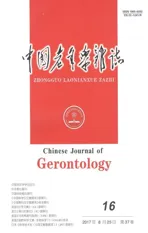基因多态性对创伤性脑损伤的影响
2017-01-17朱效伟杨明飞
朱效伟 杨明飞
(青海省人民医院神经外科,青海 西宁 810007)
基因多态性对创伤性脑损伤的影响
朱效伟 杨明飞
(青海省人民医院神经外科,青海 西宁 810007)
颅脑损伤;多态性;基因
创伤性脑损伤(TBI)治疗中仅依靠其临床表现和放射学表现来精准预测预后是非常困难的,因为尽管有相似的损伤也能有不一样的结果。人体中存在许多影响TBI预后的基因多态性,并且在预测TBI预后中有重要作用〔1〕。本文主要就目前成人TBI预后相关的基因多态性作一概述。
1 细胞因子基因多态性与TBI预后
TBI病人血脑屏障的完整性受到损害,伴随氧化应激状态和内皮细胞黏附分子表达增加,外周炎症细胞将流入损伤的脑实质,从而细胞因子成为TBI病理生理过程的主要介质〔2〕。
1.1肿瘤坏死因子(TNF)-α的基因多态性 编码人TNF-α的基因位于6号染色体上的主要组织相容性复合体(MHC)基因位置,约3 kb碱基对。TBI后血清中的TNF-α含量将早期升高晚期降低,并且有动物实验表明TNF-α缺乏在TBI中早期有利,晚期有害,这表明TNF-α同时扮演神经保护和神经毒性双面角色〔3〕。但TNF-α基因的5个多态性与TBI的研究甚少,其中Waters等〔4〕并没有观察到-238A/G多态性与预后有任何关联,但推断-308A等位基因与TBI预后差有关。还需要更多的研究来证明这个假说。
1.2白细胞介素(IL)-1多态性 IL-1由促炎性细胞因子IL-1α、IL-1β和受体拮抗剂IL-1RA构成,IL-1α、IL-1β基因多态性包括IL-1A-899C/T(rs1800587)、IL-1B-31C/T(rs1143627)、IL-1B-511G/T(rs16944)、IL-1B+3953C/T(rs1143634)、IL-1RN 5个等位基因〔5〕。Waters等〔4〕指出IL-1A-899C/T、IL-1B-31C/T、IL-1B-511G/T、IL-1B+3953C/T与TBI后6个月预后相关。
1.3IL-6的多态性 人IL-6基因位于7号染色体,其多态性中-174G/C(rs1800795)、-572G/C(rs1800796)、-597G/A(RS1800797)较常见。在-597、-174位置多态性的G等位基因已证明与健康女性个体的循环IL-6的高水平表达相关〔6〕。Dalla Libera〔7〕研究表明此位置的G等位基因与重型TBI(sTBI)不良预后相关。但有研究得出不同结果〔4〕。
1.4转化生长因子(TGF)-β多态性 TGF-β基因位于人类19号染色体上,包括-800位置(G/A置换,rs1800468)和-509位置(C/T置换,rs1800469)两个多态性,体外研究表明,-509核苷酸位置的C等位基因通过干扰转录因子的正常结合而下调基因的表达〔8〕。Waters等〔4〕报道了-800G/A和-509C/T与损伤后的继发性并发症及TBI后6个月的预后没有关联。
2 载脂蛋白(Apo)E相关基因多态性与TBI预后
ApoE基因位于19号染色体上约3.7 kb碱基,其中112(rs429358)和158(rs7412)核苷酸位点发生C、T核苷酸突变形成E2、E3、E4等位基因,其不同组ApoE2/E2、E2/E3、E2/E4、E3/E3、E3/E4、E4/E4翻译而成的ApoE蛋白平均分子量34 kD,包含299个氨基酸,含有3种亚型,E3蛋白112位为半胱氨酸,158位为精氨酸;E2都为半胱氨酸;E4都为精氨酸〔9〕。除此,基因调控序列的多态性-219G/T(rs405509)、-427T/C(rs769446)、-491A/T(rs449647)也影响ApoE基因表达。
Mayeux等〔10〕研究表明TBI与ApoE4一起加大了患阿尔茨海默病(AD)的风险。Teasdale等〔11〕发现ApoE4等位基因携带者的TBI后6个月预后较差,并且纯合子基因携带者TBI后残疾水平更高。也有学者发现ApoE4主要表达在15~30岁的人,得出ApoE4在年轻TBI患者中对预后的影响更大〔12〕。Ponsford等〔13〕发现女性TBI患者比男性患者可能有更差的预后。研究证明拥有ApoE4的TBI患者更容易发生脑细胞损伤,这可能提示ApoE4与受伤程度相关〔14〕。最近一项meta分析并没有发现ApoE4基因与TBI预后之间的关系〔15〕。
Lendon等〔16〕未发现ApoE基因启动子序列-427T/C和491A/T位基因多态性与较差预后之间的关系,但是发现-219TT个体与较差预后的关系。Jiang等〔17〕在中国的TBI患者研究中发现,-491AA同ApoE基因一起增加了TBI后发生临床恶化的风险。但没发现-219G/T或-427T/C与TBI后临床恶化之间的关系。不同等位基因在不同人群中的频率也不一样,所以比较不同民族或地理环境下的人群时必须注意这一点〔18〕。
3 微管相关蛋白(MAPT)Tau相关基因多态性与TBI预后
Tau能够稳定MAPT集合体,在中枢和外周神经系统的神经突触中高度表达,在少突胶质细胞和星形胶质细胞中则表达含量较低,Tau蛋白可以在多个位点进行磷酸化,并且已经证明高磷酸化的Tau与AD时发生的神经纤维缠结有关〔19〕。人类Tau蛋白有17号染色体上的150 kb的MAPT基因编码,基因15个外显子中的2、3、10外显子的随机剪接将会在正常成人脑组织中产生6种主要亚型〔20〕。已经证实在业余拳击运动员比赛后脑脊液(CSF)中Tau蛋白升高与头部撞击次数和严重程度相关,并且Tau蛋白浓度在休息后回归正常〔21〕。Terrell等〔20〕发现外显子6中Ser53Pro的TT基因型(rs10445337)与脑震荡后风险增加弱相关。
4 线粒体相关基因多态性与TBI预后
人类mtDNA为由16 569 bp核苷酸组成的双链环形DNA,包括37个基因。人类进化中积累了大量的mtDNA突变或单核苷酸多态性(SNP),通常被称为线粒体单体型单倍群包括H,T,U,V,W,X,Y和K。特定的SNP与特定单倍群相关联。Bulstrode等〔22〕发现拥有K单体型的TBI预后更好,并且拥有单倍群K或T显著减少年龄增大引起的线粒体功能障碍,这证实了流行病学研究显示的单倍群K的群体更长寿。ApoE已经被证明可以保护神经细胞氧化应激,并且不同的等位基因可以有不同的作用(E2>E3>E4)。Bulstrode等〔22〕观察到既拥有ApoE4基因也拥有单倍群K基因的患者TBI预后更好。研究还发现A10398等位基因(与单倍群H相关)和10398G(与单倍群K和J相关)分别与恢复的慢和快相关,同时T195C与女性病人不好的预后相关(P=0.03)〔23〕。这些研究显示了老化、创伤性脑损伤的病理生理学及急性损伤后的线粒体基因多态性与ApoE基因多态性的交互作用。
5 其他与TBI相关的基因多态性
5.1内皮型一氧化氮合酶(NOS)3基因 NOS3基因位于7号染色体,包括-786T/C、894G/T、27个氨基酸的插入(I)/缺失(D)数目可变串联重复序列(VNTR)多态性,有报道-786T/C(rs2070744)与一氧化氮mRNA水平及脑内血管痉挛相关〔24〕。有报道NOS3-786C等位基因和脑血流减少(CBF)之间的关系〔25〕,提示该基因与TBI相关。
5.2血管紧张素转化酶基因(ACE) ACE位于17号染色体,常见的是ACE I/D基因多态性,指在基因的16位内含子中有287 bp DNA的插入和缺失。研究发现拥有D等位基因比I在意识水平测试中表现差〔26〕。
5.3儿茶酚-o-甲基转移酶(COMT)基因 COMT基因位于22号染色体,其常见的SNP(rs4680)中缬氨酸(Val)变异与COMT活性增强、多巴胺(DA)含量下降有关,蛋氨酸(Met)则有相反作用〔27〕。Lipsky等〔28〕发现COMT Val158Met与TBI后1个月的执行功能、执拗性格改变等有关,但Willmott等〔29〕没有发现COMT Val158Met基因型和TBI预后的相关性。
5.45-羟色胺转运体(5-HTT)基因 5-HTT基因位于17号染色体,其包括44 bp基因的插入或缺失,形成S或L等位基因多态性,除此还有A/G(rs2553)单核苷酸多态性,导致不同等位基因的不同组合L(A)或L(G)、S(A)或S(G)〔30〕。S等位基因的单次或多次拷贝会导致携带者在面临生活重大问题时更容易产生压力,但Chan等〔31〕没有发现某个基因多态性和TBI后抑郁的关系,同样在抑郁组中也没有发现抑郁量化得分与多态性之间的关系。
5.5脑源性神经营养因子(BDNF) BDNF位于11号染色体,其中包括核苷酸+196位置的Val到Met的替换(rs6265),有报道称其与认知功能下降〔32〕、接受速度下降相关〔33〕,也有报道rs6265对神经认知功能有保护作用〔34〕。
5.6肿瘤蛋白质53基因(TP53) TP53位于17号染色体,最常见的为密码子72的G/T多态性(rs1042522),并且已经证实纯合子的G突变比T突变在引发细胞凋亡上更有效〔35〕。Martinez-Lucas等〔36〕研究发现在从外科重症监护病房(ICU)转出到普通病房时纯合子的G突变拥有3倍的不良预后风险。
5.7锚蛋白重复序列激酶结构域(ANKK)1基因 ANKK1位于11号染色体包含一个A/T多态性(又叫作Taq1A)(rs1800497),并且已经证实T等位基因与DA受体2的下调表达有关〔37〕。McAllister等〔38〕发现Taq1A多态性中T等位基因与情节记忆下降、反应潜伏期延长的关系。
5.8肾脏和脑蛋白质表达基因(KIBRA) KIBRA位于人类5号染色体,是与情景记忆有关的第1个被研究的基因,在脑组织中只表达于颞叶和海马部位,能编码在突触塑造、突触转运、功能维持、信号传递中有重要作用的蛋白质〔39〕。Wagner等〔40〕发现KIBRA基因T/C多态性(rs17070145)中的T等位基因的患者伤后的情节记忆功能在6、12个月时较差。
综上,由于实验设计、操作及结果判读等方面的不同有些结论是不同的,尚需更多、更深入、甚至更大样本含量的研究。那些不改变基因序列而影响基因表达的机制(例如,DNA甲基化,染色质修饰)也应该予以深入研究。
1Weaver SM,Portelli JN,Chau A,etal.Genetic polymorphisms and traumatic brain injury:the contribution of individual differences to recovery〔J〕.Brain Imaging Behav,2014;8(3):420-34.
2Patterson ZR,Holahan MR.Understanding the neuroinflammatory response following concussion to develop treatment strategies〔J〕.Front Cell Neurosci,2012;6:58.
3Scherbel U,Raghupathi R,Nakamura M,etal.Differential acute and chronic responses of tumor necrosis factor-deficient mice to experimental brain injury〔J〕.Proc Natl Acad Sci U S A,1999;96(15):8721-6.
4Waters RJ,Murray GD,Teasdale GM,etal.Cytokine gene polymorphisms and outcome after traumatic brain injury〔J〕.J Neurotrauma,2013;30(20):1710-6.
5Blakemore AI,Cox A,Gonzalez AM,etal.Interleukin-1 receptor antagonist allele (IL1RN*2) associated with nephropathy in diabetes mellitus〔J〕.Hum Genet,1996;97(3):369-74.
6Villuendas G,San Millán JL,Sancho J,etal.The -597 G-->A and -174 G-->C polymorphisms in the promoter of the IL-6 gene are associated with hyperandrogenism〔J〕.J Clin Endocrinol Metab,2002;87(3):1134-41.
7Dalla Libera AL,Regner A,de Paoli J,etal.IL-6 polymorphism associated with fatal outcome in patients with severe traumatic brain injury〔J〕.Brain Inj,2011;25(4):365-9.
8Derynck R,Rhee L,Chen EY,etal.Intron-exon structure of the human transforming growth factor-beta precursor gene〔J〕.Nucleic Acids Res,1987;15(7):3188-9.
9Weisgraber KH.Apolipoprotein E:structure-function relationships〔J〕.Adv Protein Chem,1994;45:249-302.
10Mayeux R,Ottman R,Maestre G,etal.Synergistic effects of traumatic head injury and apolipoprotein-epsilon 4 in patients with Alzheimer's disease〔J〕.Neurology,1995;45(3 Pt 1):555-7.
11Teasdale GM,Nicoll JA,Murray G,etal.Association of apolipoprotein E polymorphism with outcome after head injury〔J〕.Lancet,1997;350(9084):1069-71.
12Wilson JT,Pettigrew LE,Teasdale GM.Structured interviews for the glasgow outcome scale and the extended glasgow outcome scale:guidelines for their use〔J〕.J Neurotrauma,1998;15(8):573-85.
13Ponsford J,McLaren A,Schonberger M,etal.The association between apolipoprotein E and traumatic brain injury severity and functional outcome in a rehabilitation sample〔J〕.J Neurotrauma,2011;28(9):1683-92.
14Olivecrona Z,Koskinen LO.The release of S-100B and NSE in severe traumatic head injury is associated with APOE ε4〔J〕.Acta Neurochir (Wien),2012;154(4):675-80.
15Padgett CR,Summers MJ,Skilbeck CE.Is APOE ε4 associated with poorer cognitive outcome following traumatic brain injury? A meta-analysis〔J〕.Neuropsychology,2016;30(7):775-90.
16Lendon CL,Harris JM,Pritchard AL,etal.Genetic variation of the APOE promoter and outcome after head injury〔J〕.Neurology,2003;61(5):683-5.
17Jiang Y,Sun X,Gui L,etal.Correlation between APOE -491AA promoter in epsilon4 carriers and clinical deterioration in early stage of traumatic brain injury〔J〕.J Neurotrauma,2007;24(12):1802-10.
181 000 Genomes Project Consortium,Abecasis GR,Altshuler D,etal.A map of human genome variation from population-scale sequencing〔J〕.Nature,2010;467(7319):1061-73.
19Bancher C,Brunner C,Lassmann H,etal.Accumulation of abnormally phosphorylated tau precedes the formation of neurofibrillary tangles in Alzheimer's disease〔J〕.Brain Res,1989;477(1-2):90-9.
20Terrell TR,Bostick RM,Abramson R,etal.APOE,APOE promoter,and Tau genotypes and risk for concussion in college athletes〔J〕.Clin J Sport Med,2008;18(1):10-7.
21Neselius S,Brisby H,Marcusson J,etal.Neurological assessment and its relationship to CSF biomarkers in amateur boxers〔J〕.PLoS One,2014;9(6):e99870.
22Bulstrode H,Nicoll JA,Hudson G,etal.Mitochondrial DNA and traumatic brain injury〔J〕.Ann Neurol,2014;75(2):186-95.
23Conley YP,Okonkwo DO,Deslouches S,etal.Mitochondrial polymorphisms impact outcomes after severe traumatic brain injury〔J〕.J Neurotrauma,2014;31(1):34-41.
24Ko NU,Rajendran P,Kim H,etal.Endothelial nitric oxide synthase polymorphism (-786T->C) and increased risk of angiographic vasospasm after aneurysmal subarachnoid hemorrhage〔J〕.Stroke,2008;39(4):1103-8.
25Robertson CS,Gopinath SP,Valadka AB,etal.Variants of the endothelial nitric oxide gene and cerebral blood flow after severe traumatic brain injury〔J〕.J Neurotrauma,2011;28(5):727-37.
26Ariza M,Matarin MD,Junque C,etal.Influence of angiotensin-converting enzyme polymorphism on neuropsychological subacute performance in moderate and severe traumatic brain injury〔J〕.J Neuropsychiatry Clin Neurosci,2006;18(1):39-44.
27Weinshilboum RM,Otterness DM,Szumlanski CL.Methylation pharmacogenetics:catechol O-methyltransferase,thiopurine methyltransferase,and histamine N-methyltransferase〔J〕.Annu Rev Pharmacol Toxicol,1999;39:19-52.
28Lipsky RH,Sparling MB,Ryan LM,etal.Association of COMT Val158Met genotype with executive functioning following traumatic brain injury〔J〕.J Neuropsychiatry Clin Neurosci,2005;17(4):465-71.
29Willmott C,Withiel T,Ponsford J,etal.COMT Val158Met and cognitive and functional outcomes after traumatic brain injury〔J〕.J Neurotrauma,2014;31(17):1507-14.
30Nakamura M,Ueno S,Sano A,etal.The human serotonin transporter gene linked polymorphism (5-HTTLPR) shows ten novel allelic variants〔J〕.Mol Psychiatry,2000;5(1):32-8.
31Chan F,Lanctot KL,Feinstein A,etal.The serotonin transporter polymorphisms and major depression following traumatic brain injury〔J〕.Brain Inj,2008;22(6):471-9.
32Bath KG,Lee FS.Variant BDNF (Val66Met) impact on brain structure and function〔J〕.Cogn Affect Behav Neurosci,2006;6(1):79-85.
33McAllister TW,Tyler AL,Flashman LA,etal.Polymorphisms in the brain-derived neurotrophic factor gene influence memory and processing speed one month after brain injury〔J〕.J Neurotrauma,2012;29(6):1111-8.
34Barbey AK,Colom R,Paul E,etal.Preservation of general intelligence following traumatic brain injury:contributions of the Met66 brain-derived neurotrophic factor〔J〕.PLoS One,2014;9(2):e88733.
35Dumont P,Leu JI,Della Pietra AC,etal.The codon 72 polymorphic variants of p53 have markedly different apoptotic potential〔J〕.Nat Genet,2003;33(3):357-65.
36Martinez-Lucas P,Moreno-Cuesta J,Garcia-Olmo DC,etal.Relationship between the Arg72Pro polymorphism of p53 and outcome for patients with traumatic brain injury〔J〕.Intensive Care Med,2005;31(9):1168-73.
37Thompson J,Thomas N,Singleton A,etal.D2 dopamine receptor gene (DRD2) Taq1 a polymorphism:reduced dopamine D2 receptor binding in the human striatum associated with the A1 allele〔J〕.Pharmacogenetics,1997;7(6):479-84.
38McAllister TW,Rhodes CH,Flashman LA,etal.Effect of the dopamine D2 receptor T allele on response latency after mild traumatic brain injury〔J〕.Am J Psychiatry,2005;162(9):1749-51.
39Schneider A,Huentelman MJ,Kremerskothen J,etal.KIBRA:a new gateway to learning and memory〔J〕?Front Aging Neurosci,2010;2:4.
40Wagner AK,Hatz LE,Scanlon JM,etal.Association of KIBRA rs17070145 polymorphism and episodic memory in individuals with severe TBI〔J〕.Brain Inj,2012;26(13-14):1658-69.
〔2016-12-29修回〕
(编辑 王一涵)
青海省自然科学基金资助项目(No.2015-ZJ-912)
杨明飞(1975-),男,硕士,主任医师,硕士生导师,主要从事颅脑损伤研究。
朱效伟(1991-),男,在读硕士,主要从事颅脑损伤研究。
R65
A
1005-9202(2017)16-4151-03;doi:10.3969/j.issn.1005-9202.2017.16.108
